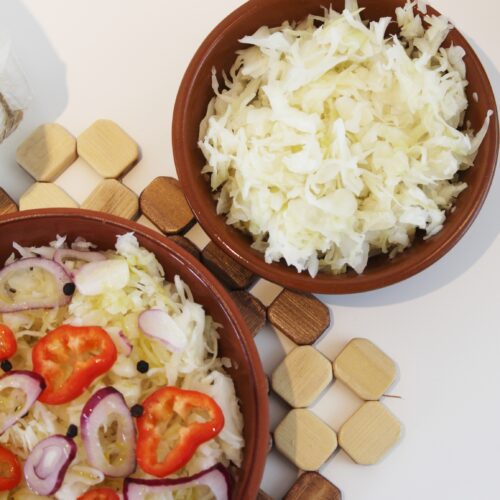
Fermented Magic: The Nutrient-Rich Sauerkraut Recipe
"Ukrainian kimchi" isn't just a flavorful addition to your meals; it’s a powerhouse of health benefits. Enjoy your Sauerkraut and let your health thrive! 🥬✨
Equipment
- 1 clean, sterilized glass jar
- 1 large mixing bowl not plastic!
- 1 clean cloth or paper towel
Ingredients
- 2,2 lb cabbage 1 kg
- 20 g sea salt
Instructions
- Finely shred the cabbage using a sharp knife or a mandoline slicer. I usually use my food processor.
- Place the shredded cabbage in a large mixing bowl. Sprinkle the sea salt.
- With clean hands, massage the salt and spices into the cabbage and carrots. This helps release the natural juices from the vegetables. Continue massaging until the mixture becomes slightly wet and juicy. The mix will also decrease in volume.
- Begin tightly packing the cabbage and carrot mixture into the glass jar. Press down firmly with your hands to remove any air pockets. Ensure the vegetables are submerged in their juices. Leave about 1-2 inches of space at the top of the jar to allow for the sauerkraut to expand during fermentation.
- Cover the jar with a clean cloth or paper towel, secured with a rubber band or string. This allows air to flow while keeping dust out. Place the jar in a place with a stable temperature (around 65-70°F or 18-21°C) for 1-2 weeks. During the warm season, my fermented cabbage is ready in 4-5 days.
- Check the fermented cabbage every day. You may see bubbles forming, which is a sign of fermentation. Pierce with a wooden skewer to release some air. Taste the sauerkraut after 5 days to assess its tanginess. If it's to your liking, move the jar to the refrigerator to slow down the fermentation process. If you prefer a stronger flavor, let it ferment for another few days before refrigerating.
- Once fermented to your desired taste, your sauerkraut is ready to enjoy! Serve it as a side dish, in sandwiches, or as a topping for salads. Remember, homemade sauerkraut will continue to develop flavor over time in the refrigerator.
Notes
- The salt-to-cabbage ratio is critical in sauerkraut making because it directly impacts the fermentation process. In this recipe, the proportion of 20 g of salt per 1 kg of cabbage creates the ideal environment for beneficial bacteria to thrive while inhibiting the growth of harmful bacteria.
- Ideally, it's best to use non-iodized salt, such as sea salt or pickling salt. Iodine can interfere with the fermentation process. Stick to pure, non-iodized salt to ensure a successful and flavorful batch of sauerkraut.
- Not all cabbages are equal when it comes to sauerkraut. Choosing the right cabbage variety is crucial. Opt for firm, dense varieties like green or white cabbage, which have a high water content. Avoid softer types like Savoy cabbage, as they might not provide enough crunch after fermentation.
Tried this recipe?Let us know how it was!